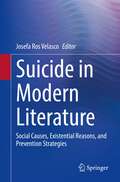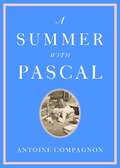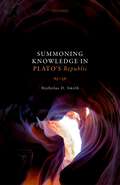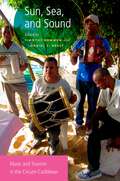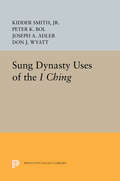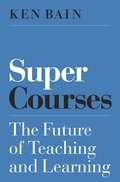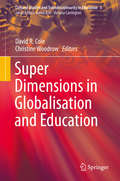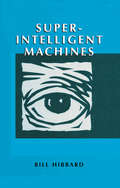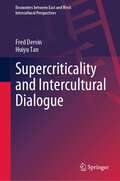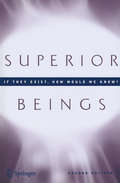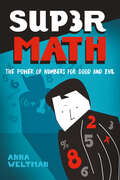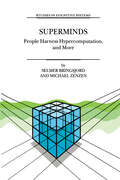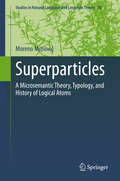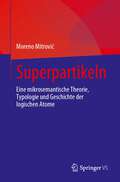- Table View
- List View
Suicide in Modern Literature: Social Causes, Existential Reasons, and Prevention Strategies
by Josefa Ros VelascoThis book analyzes the social and contextual causes of suicide, the existential and philosophical reasons for committing suicide, and the prevention strategies that modern fictional literature places at our disposal. They go through the review of Modern fictional literature, in the American and European geographical framework, following the rationales that modern literature based on fiction can serve the purpose of understanding better the phenomenon of suicide, its most inaccessible impulses, and that has the potential to prevent suicide.From the turn of the 20th century to the present, debates over the meaning of suicide became a privileged site for efforts to discover the reasons why people commit suicide and how to prevent this behavior. Since the French sociologist and philosopher Émile Durkheim published his study Suicide: A Study in Sociology in 1897, a reframing of suicide took place, giving rise to a flourishing group of researchers and authors devoting their efforts to understand better the causes of suicide and to the formation of suicide prevention organizations. A century later, we still keep on trying to reach such an understanding of suicide, the nature, and nuances of its modern conceptualization, to prevent suicidal behaviors.The question of what suicide means in and for modernity is not an overcome one. Suicide is an act that touches all of our lives and engages with the incomprehensible and unsayable. Since the turn of the millennium, a fierce debate about the state’s role in assisted suicide has been adopted. Beyond the discussion as to whether physicians should assist in the suicide of patients with unbearable and hopeless suffering, the scope of the suicidal agency is much broader concerning general people wanting to die.
The Sum of All Heresies: The Image of Islam in Western Thought
by Frederick QuinnCurrent global tensions and the spread of terrorism have resurrected in the West a largely negative perception of Islamic society, an ill will fueled by centuries of conflict and prejudice. Shedding light on the history behind these hostile feelings, Frederick Quinn's timely volume traces the Western image of Islam from its earliest days to recent times. Quinn establishes four basic themes around which the image of Islam gravitates throughout history: the Prophet as Antichrist, heretic, and Satan; the Prophet as Fallen Christian, corrupted monk, or Arab Lucifer; the prophet as sexual deviant, polygamist, and charlatan, and the Prophet as Wise Easterner, Holy Person, and dispenser of wisdom. A feature of the book is a strong portrayal of Islam in literature, art, music, and popular culture, drawing on such sources as Cervantes's Don Quixote; the Orientalism of numerous visual artists; the classical music of Monteverdi and Mozart; and more recent cultural manifestations, such as music hall artists like Peter Dawson and Edith Piaf; and stage or silver screen representations like The Garden of Allah, The Sheik, Aladdin, and The Battle of Algiers. Quinn argues that an outpouring of positive information on basically every aspect of Islamic life has yet to vanquish the hostile and malformed ideas from the past. Conflict, mistrust, and misunderstanding characterize the Muslim-Christian encounter, and growing examples of cooperation are often overshadowed by anger and suspicion. In this important book, Quinn highlights long-standing historical prejudices but also introduces the reader to some of the landmark voices in history that have worked toward a greater understanding of Islam.
The Sum of All Heresies: The Image of Islam in Western Thought
by Frederick QuinnCurrent global tensions and the spread of terrorism have resurrected in the West a largely negative perception of Islamic society, an ill will fueled by centuries of conflict and prejudice. Shedding light on the history behind these hostile feelings, Frederick Quinn's timely volume traces the Western image of Islam from its earliest days to recent times. Quinn establishes four basic themes around which the image of Islam gravitates throughout history: the Prophet as Antichrist, heretic, and Satan; the Prophet as Fallen Christian, corrupted monk, or Arab Lucifer; the prophet as sexual deviant, polygamist, and charlatan, and the Prophet as Wise Easterner, Holy Person, and dispenser of wisdom. A feature of the book is a strong portrayal of Islam in literature, art, music, and popular culture, drawing on such sources as Cervantes's Don Quixote; the Orientalism of numerous visual artists; the classical music of Monteverdi and Mozart; and more recent cultural manifestations, such as music hall artists like Peter Dawson and Edith Piaf; and stage or silver screen representations like The Garden of Allah, The Sheik, Aladdin, and The Battle of Algiers. Quinn argues that an outpouring of positive information on basically every aspect of Islamic life has yet to vanquish the hostile and malformed ideas from the past. Conflict, mistrust, and misunderstanding characterize the Muslim-Christian encounter, and growing examples of cooperation are often overshadowed by anger and suspicion. In this important book, Quinn highlights long-standing historical prejudices but also introduces the reader to some of the landmark voices in history that have worked toward a greater understanding of Islam.
The Sum of the People: How the Census Has Shaped Nations, from the Ancient World to the Modern Age
by Andrew WhitbyThis fascinating three-thousand-year history of the census traces the making of the modern survey and explores its political power in the age of big data and surveillance.In April 2020, the United States will embark on what has been called "the largest peacetime mobilization in American history": the decennial population census. It is part of a tradition of counting people that goes back at least three millennia and now spans the globe.In The Sum of the People, data scientist Andrew Whitby traces the remarkable history of the census, from ancient China and the Roman Empire, through revolutionary America and Nazi-occupied Europe, to the steps of the Supreme Court. Marvels of democracy, instruments of exclusion, and, at worst, tools of tyranny and genocide, censuses have always profoundly shaped the societies we've built. Today, as we struggle to resist the creep of mass surveillance, the traditional census -- direct and transparent -- may offer the seeds of an alternative.
A Summary of Scientific Method (SpringerBriefs in Philosophy)
by Peter KossoA Summary of Scientific Method is a brief description of what makes science scientific. It is written in a direct, clear style that is accessible and informative for scientists and science students. It is intended to help science teachers explain how science works, highlighting strengths without ignoring limitations, and to help scientists articulate the process and standards of their work. The book demonstrates that there are several important requirements for being scientific, and the most fundamental of these is maintaining an extensive, interconnected, coherent network of ideas. Some components in the network are empirical, others are theoretical, and they support each other. Clarifying the structure of this web of knowledge explains the role of the commonly cited aspects of scientific method, things like hypotheses, theories, testing, evidence, and the like. A Summary of Scientific Method provides a clear, intuitive, and accurate model of scientific method.
A Summer with Montaigne: On the Art of Living Well
by Antoine CompagnonA few years ago, Antoine Compagnon was asked to host a radio broadcast, every day for an entire summer, on a formidable subject: Michel de Montaigne. From that experience came this engaging and entertaining book, A Summer with Montaigne. An intelligent and thought-provoking treatise in forty chapters that will introduce readers unfamiliar with Montaigne to his unique brilliance and remind those who already know Montaigne’s work of its vitality, force, and enduring timeliness.Compagnon breathes life into the musings of Montaigne, approaching his subject not as the recluse many imagine him to have been, but rather a multi-faceted individual of complex thought and astonishing analytical prowess. Once the mayor of Bordeaux, Montaigne was a committed spirit of his time, advising his powerful contemporaries and always in touch with the questions and concerns of the moment, of which many remain pressing today. Composed over a period of twenty years, Montaigne’s Essays deal with timeless themes. From the problems posed by religion, war, power and friendship to humankind’s ridiculous weaknesses, Montaigne’s Essays remain a moving commentary on what it means to be a human being in any age.
A Summer with Pascal
by Antoine CompagnonFrom an eminent scholar, a spirited introduction to one of the great polymaths in the history of Europe.Blaise Pascal (1623–1662) is best known in the English-speaking world for his contributions to mathematics and physics, with both a triangle and a law in fluid mechanics named after him. Meanwhile, the classic film My Night at Maud’s popularized Pascal’s wager, an invitation to faith that has inspired generations of theologians. Despite the immensity of his reputation, few read him outside French schools. In A Summer with Pascal, celebrated literary critic Antoine Compagnon opens our minds to a figure somehow both towering and ignored.Compagnon provides a bird’s-eye view of Pascal’s life and significance, making this volume an ideal introduction. Still, scholars and neophytes alike will profit greatly from his masterful readings of the Pensées—a cornerstone of Western philosophy—and the Provincial Letters, in which Pascal advanced wry theological critiques of his contemporaries. The concise, taut chapters build upon one another, easing into writings often thought to be forbidding and dour. With Compagnon as our guide, these works are not just accessible but enchanting.A Summer with Pascal brings the early modern thinker to life in the present. In an age of profound existential doubt and assaults on truth and reason, in which religion and science are so often crudely opposed, Pascal’s sophisticated commitment to both challenges us to meet the world with true intellectual vigor.
Summoning Knowledge in Plato's Republic
by Nicholas D. SmithNicholas D. Smith presents an original interpretation of the Republic, considering it to be a book about knowledge and education. Over the course of Summoning Knowledge in Plato's Republic, he argues for four main theses. Firstly, the Republic is not just a work that has a lot to say about education; it is a book that depicts Socrates as attempting to engage his interlocutors in such a way as to help to educate them and also engages us, the readers, in a way that helps to educate us. Secondly, Plato does not suppose that education, properly understood, should have as its primary aim putting knowledge into souls that do not already have it. Instead, the education Plato discusses, represents occurring between Socrates and his interlocutors, and hopes to achieve in his readers is one that aims to arouse the power of knowledge in us and then to begin to train that power always to engage with what is more real, rather than what is less real. Thirdly, Plato's conception of knowledge is not the one typically presented in contemporary epistemology. It is, rather, the power of conceptualization by the use of exemplars. And finally, Plato engages this power of knowledge in the Republic in a way he represents as only a kind of second-best way to engage knowledge - and not as the best way, which would be dialectic. Instead, Plato uses images that summon the power of knowledge to begin the process by which the power may become fully realized.
Summoning Knowledge in Plato's Republic
by Nicholas D. SmithNicholas D. Smith presents an original interpretation of the Republic, considering it to be a book about knowledge and education. Over the course of Summoning Knowledge in Plato's Republic, he argues for four main theses. Firstly, the Republic is not just a work that has a lot to say about education; it is a book that depicts Socrates as attempting to engage his interlocutors in such a way as to help to educate them and also engages us, the readers, in a way that helps to educate us. Secondly, Plato does not suppose that education, properly understood, should have as its primary aim putting knowledge into souls that do not already have it. Instead, the education Plato discusses, represents occurring between Socrates and his interlocutors, and hopes to achieve in his readers is one that aims to arouse the power of knowledge in us and then to begin to train that power always to engage with what is more real, rather than what is less real. Thirdly, Plato's conception of knowledge is not the one typically presented in contemporary epistemology. It is, rather, the power of conceptualization by the use of exemplars. And finally, Plato engages this power of knowledge in the Republic in a way he represents as only a kind of second-best way to engage knowledge - and not as the best way, which would be dialectic. Instead, Plato uses images that summon the power of knowledge to begin the process by which the power may become fully realized.
Sung Dynasty Uses of the I Ching
by Kidder Smith Jr. Peter K. Bol Joseph A. Adler Don J. WyattThe I Ching, or Book of Changes, has been one of the two or three most influential books in the Chinese canon. It has been used by people on all levels of society, both as a method of divination and as a source of essential ideas about the nature of heaven, earth, and humankind. During the eleventh and twelfth centuries, Sung dynasty literati turned to it for guidance in their fundamental reworking of the classical traditions. This book explores how four leading thinkers--Su Shih, Shao Yung, Ch'eng I, and Chu Hsi--applied the I Ching to these projects. These four men used the Book of Changes in strikingly different ways. Yet each claimed to find in it a sure foundation for human values. Their work established not only new meanings for the text but also new models for governance and moral philosophy that would be debated throughout the next thousand years of Chinese intellectual history. By focusing on their uses of the I Ching, this study casts a unique light on the complex continuity-within-change and rich diversity of Sung culture.Originally published in 1990.The Princeton Legacy Library uses the latest print-on-demand technology to again make available previously out-of-print books from the distinguished backlist of Princeton University Press. These editions preserve the original texts of these important books while presenting them in durable paperback and hardcover editions. The goal of the Princeton Legacy Library is to vastly increase access to the rich scholarly heritage found in the thousands of books published by Princeton University Press since its founding in 1905.
Super Courses: The Future of Teaching and Learning (Skills for Scholars)
by Ken BainFrom the bestselling author of What the Best College Teachers Do, the story of a new breed of amazingly innovative courses that inspire students and improve learningDecades of research have produced profound insights into how student learning and motivation can be unleashed—and it’s not through technology or even the best of lectures. In Super Courses, education expert and bestselling author Ken Bain tells the fascinating story of enterprising college, graduate school, and high school teachers who are using evidence-based approaches to spark deeper levels of learning, critical thinking, and creativity—whether teaching online, in class, or in the field.Visiting schools across the United States as well as in China and Singapore, Bain, working with his longtime collaborator, Marsha Marshall Bain, uncovers super courses throughout the humanities and sciences. At the University of Virginia, undergrads contemplate the big questions that drove Tolstoy—by working with juveniles at a maximum-security correctional facility. Harvard physics students learn about the universe not through lectures but from their peers in a class where even reading is a social event. And students at a Dallas high school use dance to develop growth mindsets—and many of them go on to top colleges, including Juilliard. Bain defines these as super courses because they all use powerful researched-based elements to build a “natural critical learning environment” that fosters intrinsic motivation, self-directed learning, and self-reflective reasoning. Complete with sample syllabi, the book shows teachers how they can build their own super courses.The story of a hugely important breakthrough in education, Super Courses reveals how these classes can help students reach their full potential, equip them to lead happy and productive lives, and meet the world’s complex challenges.
Super Dimensions in Globalisation and Education (Cultural Studies and Transdisciplinarity in Education #5)
by David R. Cole Christine WoodrowThis volume is the first major production of the globalisation research strand of the Centre for Educational Research at Western Sydney University. This book makes a significant contribution to the theory of and research in globalisation and education, and tackles the topics of superdiversity and supercomplexity. The book’s thesis is that the effects of globalisation on education can only be understood if the specific yet complex conditions of globalisation in education are investigated. The book takes an international approach to understanding globalisation and does not restrict itself to just one methodological or theoretical plane of investigation.Education is one of these frontline domains in which the effects of superdiversity cannot be dismissed, minimized or denied. The continuously increasing complexity of learning environments is raising critical issues at every level, from description over analysis to theoretical generalization, and this book is a first and fruitful attempt at charting these waters. This pioneering book will remain a key text for many years to come.Jan BloomaertProfessor of Language, Culture and Globalization and Director of the Babylon CenterTilburg University, the Netherlands. This provocative collection works from two premises: that today there is superdiversity in our globalised world and related is a supercomplexity of theoretical and methodological approaches. The collection proffers multifarious challenges for educational theory, research and practice in working with, through and across these two premises. As such, Super Dimensions in Globalisation and Education is essential reading for all educational researchers, whatever their interests or location.Professor Bob LingardThe University of Queensland, Australia. This is a highly imaginative book that stops ‘flat earth’ and convergence arguments dead in their tracks. Its genius is to bring super-complexity and super-diversity into a conversation with each other and with education, and in doing so shed light on the numerous and unexpected ways in which global processes are shaping education in revealing and compelling ways. Any scholar concerned with globalisation and education will find Super Dimensions in Globalisation and Education a’ must have’ on their reading list. Professor Susan RobertsonDirector of the Centre for Globalisation, Education and Social FuturesUniversity of Bristol, UK. This is an absorbing and compelling collection. It takes readers on a kaleidoscopic journey through various intricate expressions of the nexus between globalisation and education. And it offers multiple ways that such expressions can be thought and rethought. In transcending conventional categorisations it invites educators to do so too. Professor Jane Kenway, Australian Professorial Fellow – Australian Research Council, Education Faculty, Monash University, Australia.
Super-Intelligent Machines (Ifsr Ser.)
by Bill HibbardSuper-Intelligent Machines combines neuroscience and computer science to analyze future intelligent machines. It describes how they will mimic the learning structures of human brains to serve billions of people via the network, and the superior level of consciousness this will give them. Whereas human learning is reinforced by self-interests, this book describes the selfless and compassionate values that must drive machine learning in order to protect human society. Technology will change life much more in the twenty-first century than it has in the twentieth, and Super-Intelligent Machines explains how that can be an advantage.
Supercriticality and Intercultural Dialogue (Encounters between East and West)
by Fred Dervin Huiyu TanThis book offers a snapshot of interculturality as a complex, unstable and highly political object of research and education when it locates at the centre of multifaceted dialogues between teachers and students; students and students; teachers, students, scholars and readers. The context of the book is a Chinese course on intercultural communication education where students engage with local and international teachers. By listening to the intriguing and stimulating voices of these students in dialogue with the teachers, the reader also has the opportunity to enter the intercultural world of Chinese youth, beyond stereotypes. The unique approach proposed in the book is of interest to students, teachers of intercultural communication education, teacher educators, researchers and anyone wishing to build up supercriticality in relation to the fascinating notion of interculturality. The book contains 15 chapters and revolves around five main dialogues between the students and their teachers. Following each dialogue, the floor is given to the students to react to the dialogues and to share their views on questions that emerged from the main dialogues. The book conveys the authors’ excitement about approaching interculturality in supercritical ways, engaging in the process with multiple voices.
The Superhumanities: Historical Precedents, Moral Objections, New Realities
by Jeffrey J. KripalA bold challenge to rethink the humanities as intimately connected to the superhuman and to “decolonize reality itself.” What would happen if we reimagined the humanities as the superhumanities? If we acknowledged and celebrated the undercurrent of the fantastic within our humanistic disciplines, entirely new cultural worlds and meanings would become possible. That is Jeffrey J. Kripal’s vision for the future—to revive the suppressed dimension of the superhumanities, which consists of rare but real altered states of knowledge that have driven the creative processes of many of our most revered authors, artists, and activists. In Kripal’s telling, the history of the humanities is filled with precognitive dreams, evolving superhumans, and doubled selves. The basic idea of the superhuman, for Kripal, is at the core of who and what the human species has tried to become over millennia and around the planet. After diagnosing the basic malaise of the humanities—that the truth must be depressing—Kripal shows how it can all be done differently. He argues that we have to decolonize reality itself if we are going to take human diversity seriously. Toward this pluralist end, he engages psychoanalytic, Black critical, feminist, postcolonial, queer, and ecocritical theory. He works through objections to the superhumanities while also recognizing the new realities represented by the contemporary sciences. In doing so, he tries to move beyond naysaying practices of critique toward a future that can embrace those critiques within a more holistic view—a view that recognizes the human being as both a social-political animal as well as an evolved cosmic species that understands and experiences itself as something super.
Superior Beings. If They Exist, How Would We Know?: Game-Theoretic Implications of Omnipotence, Omniscience, Immortality, and Incomprehensibility
by Steven BramsThis book examines theology and the idea of a superior being in the context of game theory. The central question posed in this book is: If there existed a superior being who possessed the supernatural qualities of omniscience, omnipotence, immortality, and incomprehensibility, how would he/she act differently from us? The mathematical theory of games is used to define each of these qualities, and different assumptions about the rules of play in several theological games that might be played between ordinary human beings and superior beings like God are posited.
Superman and Philosophy: What Would the Man of Steel Do? (The Blackwell Philosophy and Pop Culture Series #82)
by William IrwinGo beyond the cape and into the mind of the Man of Steel, in time for release of Zack Snyder's Man of Steel movie and Superman's 75th anniversary He has thrilled millions for 75 years, with a legacy that transcends national, cultural, and generational borders, but is there more to the Man of Steel than just your average mythic superhero in a cape? The 20 chapters in this book present a fascinating exploration of some of the deeper philosophical questions raised by Superman, the Last Son of Krypton and the newest hero in the Blackwell Philosophy and Pop Culture arsenal.
Superman and Philosophy: What Would the Man of Steel Do? (The Blackwell Philosophy and Pop Culture Series #79)
by William IrwinGo beyond the cape and into the mind of the Man of Steel, in time for release of Zack Snyder's Man of Steel movie and Superman's 75th anniversary He has thrilled millions for 75 years, with a legacy that transcends national, cultural, and generational borders, but is there more to the Man of Steel than just your average mythic superhero in a cape? The 20 chapters in this book present a fascinating exploration of some of the deeper philosophical questions raised by Superman, the Last Son of Krypton and the newest hero in the Blackwell Philosophy and Pop Culture arsenal.
Supermath: The Power of Numbers for Good and Evil
by Anna WeltmanArchaeologists decoding ancient messages. Epidemiologists analyzing the spread of a contagious disease. African Americans seeking full enfranchisement in a society that has worked to exclude them. A family doing puzzles at the kitchen table. These scenarios seem to have little in common. But in fact, each of these groups is faced with a multifaceted challenge—and each is using math to solve it.In Supermath, popular author and educator Anna Weltman showcases the incredible power of mathematics when people apply it outside of the world of pure numbers, introducing it into the realms of science, politics, history, education, and art. Her stories share how math has protected us from war and disease, helped us communicate across time and space, and made the world a fairer and more beautiful place. But Weltman also warns us that dangers arise when the transformative might of numbers goes unchecked. Mathematics has been used to mistranslate records, silence indigenous communities, create gerrymandered voting districts, close the gates of higher education. Sometimes, math can blind those who wield it to its limitations, causing those who would deploy it to solve problems to instead create more. Drawing on history and current events, Weltman tackles five fascinating questions: Is math the universal language? Can math eliminate bias? Can math predict the next move? Can math open doors? And finally, What is genuine beauty? Supermath is an enlightening book that pursues complex lines of mathematical thought while providing a fascinating lens into global problems and human culture as a whole.
Superminds: People Harness Hypercomputation, and More (Studies in Cognitive Systems #29)
by Selmer Bringsjord M. ZenzenThis is the first book-length presentation and defense of a new theory of human and machine cognition, according to which human persons are superminds. Superminds are capable of processing information not only at and below the level of Turing machines (standard computers), but above that level (the "Turing Limit"), as information processing devices that have not yet been (and perhaps can never be) built, but have been mathematically specified; these devices are known as super-Turing machines or hypercomputers. Superminds, as explained herein, also have properties no machine, whether above or below the Turing Limit, can have. The present book is the third and pivotal volume in Bringsjord's supermind quartet; the first two books were What Robots Can and Can't Be (Kluwer) and AI and Literary Creativity (Lawrence Erlbaum). The final chapter of this book offers eight prescriptions for the concrete practice of AI and cognitive science in light of the fact that we are superminds.
Supernatural and Philosophy: Metaphysics and Monsters ... for Idjits (The Blackwell Philosophy and Pop Culture Series #75)
by William IrwinNo doubt the years hunting monsters and saving the universe have had their toll on the Winchesters, but their toughest and most gruesome battles are contained in this book. Think Lucifer was diabolically clever? Think again. No son is more wayward than the one who squanders his intellect and academic career pursuing questions as poignant as “Half-awesome? That’s full-on good, right?” Gathered here for the first time since the formation of Purgatory, a collection of research so arcane and horrific that it would make even the late, great Bobby Singer blush. Supernatural and Philosophy tackles all the big ideas in the long-running hit show Supernatural, covering thorny issues in a fun and accessible way. Even those unfamiliar with the show will find fascinating insights into Heaven, Hell, Angels, Demons, God, and Lucifer. A unique collection of insights into the many philosophical, religious, and paranormal topics in the hit TV show, Supernatural Accessible treatment of thorny issues for a general audience Written by philosophical fans of the show, for philosophical fans of the show Those unfamiliar with the show will still find fascinating insights into Heaven, Hell, Angels, Demons, God, Lucifer, and Good and Evil Contributors tackle issues ranging from the biological classifications of monsters, to the epistemological problems of ghost hunting
Supernatural and Philosophy: Metaphysics and Monsters ... for Idjits (The Blackwell Philosophy and Pop Culture Series #75)
by William IrwinNo doubt the years hunting monsters and saving the universe have had their toll on the Winchesters, but their toughest and most gruesome battles are contained in this book. Think Lucifer was diabolically clever? Think again. No son is more wayward than the one who squanders his intellect and academic career pursuing questions as poignant as “Half-awesome? That’s full-on good, right?” Gathered here for the first time since the formation of Purgatory, a collection of research so arcane and horrific that it would make even the late, great Bobby Singer blush. Supernatural and Philosophy tackles all the big ideas in the long-running hit show Supernatural, covering thorny issues in a fun and accessible way. Even those unfamiliar with the show will find fascinating insights into Heaven, Hell, Angels, Demons, God, and Lucifer. A unique collection of insights into the many philosophical, religious, and paranormal topics in the hit TV show, Supernatural Accessible treatment of thorny issues for a general audience Written by philosophical fans of the show, for philosophical fans of the show Those unfamiliar with the show will still find fascinating insights into Heaven, Hell, Angels, Demons, God, Lucifer, and Good and Evil Contributors tackle issues ranging from the biological classifications of monsters, to the epistemological problems of ghost hunting
Superparticles: A Microsemantic Theory, Typology, and History of Logical Atoms (Studies in Natural Language and Linguistic Theory #98)
by Moreno MitrovićThis book is all about the captivating ability that the human language has to express intricately logical (mathematical) meanings using tiny (microsemantic) morphemes as utilities. Languages mark meanings with identical inferences using identical particles and these particles thus creep up in a wide array of expressions. Because of their multi-tasking capacity to express seemingly disparate meanings, they are dubbed Superparticles. These particles are perfect windows into the interlock of several grammatical modules and the nature of the interaction of these modules through time. With a firm footing in the module where grammatical bones are built and assembled (narrow morpho-syntax), superparticles acquire varied interpretation (in the conceptual-intentional module – semantics) depending on the structure they fea- ture in. What is more, some of the interpretations these particles trigger are inferential and belong, under the standard account, to the realm of pragmatics. How can such tiny particles, rarely exceeding a syllable of sound, have such powerful and over-arching effects across the inter-modular grammatical space? This is the Platonic background against which this book is set.
Superpartikeln: Eine mikrosemantische Theorie, Typologie und Geschichte der logischen Atome
by Moreno MitrovićIn diesem Buch geht es um die faszinierende Fähigkeit der menschlichen Sprache, mit Hilfe winziger (mikrosemantischer) Morpheme als Hilfsmittel komplizierte logische (mathematische) Bedeutungen auszudrücken. Sprachen markieren Bedeutungen mit identischen Schlussfolgerungen, indem sie identische Partikel verwenden, und diese Partikel schleichen sich so in eine Vielzahl von Ausdrücken ein. Aufgrund ihrer Multitasking-Fähigkeit, scheinbar disparate Bedeutungen auszudrücken, werden sie als Superpartikel bezeichnet. Diese Partikel sind perfekte Fenster in die Verzahnung mehrerer grammatischer Module und die Art der Interaktion dieser Module im Laufe der Zeit. Fest verankert in dem Modul, in dem die grammatischen Knochen gebaut und zusammengesetzt werden (enge Morphosyntax), erhalten Superpartikel je nach der Struktur, in der sie vorkommen, unterschiedliche Interpretationen (im begrifflich-intentionalen Modul - Semantik). Darüber hinaus sind einige der Interpretationen, die diese Partikel auslösen, inferentiell und gehören nach der Standardrechnung in den Bereich der Pragmatik. Wie können so winzige Partikel, die selten länger als eine Silbe sind, so mächtige und übergreifende Wirkungen im intermodularen grammatischen Raum haben? Dies ist der platonische Hintergrund, vor dem dieses Buch steht.
